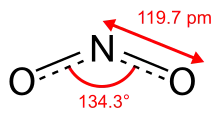
Nitrogen dioxide
Nitryl is the nitrogen dioxide (NO2) moiety when it occurs in a larger compound as a univalent fragment. Examples include nitryl fluoride (NO2F) and nitryl chloride (NO2Cl).[1]
Like nitrogen dioxide, the nitryl moiety contains a nitrogen atom with two bonds to the two oxygen atoms, and a third bond shared equally between the nitrogen and the two oxygen atoms. The nitrogen-centred radical is then free to form a bond with another univalent fragment (X) to produce an N−X bond, where X can be F, Cl, OH, etc.
In organic nomenclature, the nitryl moiety is known as the nitro group. For instance, nitryl benzene is normally called nitrobenzene (PhNO2).[2]
See also
- Dinitrogen tetroxide
- Nitro compound
- Nitrosyl (R−N=O)
- Isocyanide (R−N≡C)
- Nitryl fluoride
- Nitrate
References
- ↑ Nomenclature of Inorganic Chemistry IUPAC Recommendations 2005 (PDF). IUPAC. 2005. Archived from the original (PDF) on 2014-12-22. Retrieved 2018-11-27.
- ↑ International Union of Pure and Applied Chemistry, Commission on the Nomenclature of Organic Chemistry (1993). A guide to IUPAC nomenclature of organic compounds: Recommendations 1993. Panico, Robert; Powell, Warren H.; Richer, Jean-Claude. Oxford: Blackwell Scientific Publications. ISBN 0632037024. OCLC 27431284.
This article is issued from Wikipedia. The text is licensed under Creative Commons - Attribution - Sharealike. Additional terms may apply for the media files.